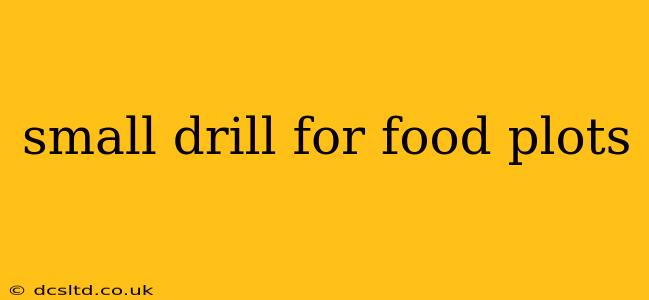Planting food plots for wildlife is a rewarding endeavor, offering a significant boost to local ecosystems and providing excellent hunting opportunities. Choosing the right equipment is crucial for success, and for smaller plots, a small drill is often the ideal solution. This guide will delve into the benefits, considerations, and best practices for utilizing small drills in establishing thriving food plots.
What Size Drill Do I Need for a Small Food Plot?
The ideal size of a drill depends entirely on the size of your food plot. For very small plots (under an acre), a manual push drill might suffice. For larger small plots (up to a few acres), a small, tow-behind drill becomes much more efficient. Consider the total area you need to plant and the time you're willing to invest in the planting process. A larger plot might justify the investment in a larger, more efficient machine despite its greater cost.
What are the Benefits of Using a Small Drill for Food Plots?
Using a small drill, whether manual or tow-behind, offers several key advantages over broadcasting seeds by hand:
- Consistent Seed Depth: Drills ensure seeds are planted at the optimal depth for germination, leading to higher germination rates and a more uniform stand. Hand-broadcasting often results in uneven seed distribution and depth, reducing overall success.
- Precise Seed Spacing: Small drills allow for precise seed spacing, preventing overcrowding and promoting healthier plant growth. This leads to better resource utilization and higher yields.
- Time Efficiency: While manual drills require more physical effort, they are still considerably faster than hand-broadcasting for larger areas. Tow-behind drills significantly increase planting speed, especially for several acres.
- Reduced Seed Waste: Drills minimize seed loss compared to broadcasting, where seeds can easily be lost to wind or birds. This translates to cost savings in the long run.
- Improved Germination Rates: The combination of consistent depth and spacing dramatically increases the percentage of seeds that germinate successfully.
What Types of Small Drills are Available?
The market offers a variety of small drills suitable for food plots:
- Manual Push Drills: These are ideal for very small plots, are affordable, and require no external power source. However, they are labor-intensive and may not be suitable for larger areas or challenging terrain.
- Small Tow-Behind Drills: These are more efficient than manual drills and are suitable for plots up to several acres. They require an ATV or small tractor for towing. Features can vary greatly, including seed hopper size and metering mechanisms.
- Electric Seeders: While not strictly "drills" in the traditional sense, electric spreaders can provide a good alternative, especially for broadcasting smaller seeds. However, they may lack the precision of a drill in terms of seed depth and spacing.
How Do I Choose the Right Small Drill for My Needs?
Choosing the right drill depends on several factors:
- Plot Size: The size of your food plot is the most important factor in determining the appropriate drill size and type.
- Budget: Manual push drills are the most affordable, while tow-behind drills represent a larger investment.
- Terrain: The terrain of your food plot will impact your choice; rough terrain may require a more robust tow-behind drill.
- Seed Type: The size and type of seeds you plan to plant will affect your choice of drill, with some drills being better suited for specific seed sizes.
What are the Best Practices for Using a Small Drill for Food Plots?
- Proper Soil Preparation: Proper soil preparation is crucial for successful planting. This includes tilling, harrowing, and fertilization.
- Calibration: Always calibrate your drill to ensure accurate seed distribution.
- Seed Selection: Choose high-quality seeds suited to your climate and soil conditions.
- Planting Depth: Plant seeds at the recommended depth for optimal germination.
- Post-Planting Care: Provide adequate watering and weed control after planting.
By carefully considering these factors and following best practices, you can maximize the effectiveness of your small drill and create thriving food plots that benefit wildlife and enhance your hunting experience. Remember to research local regulations and land-use permissions before undertaking any food plot establishment.
